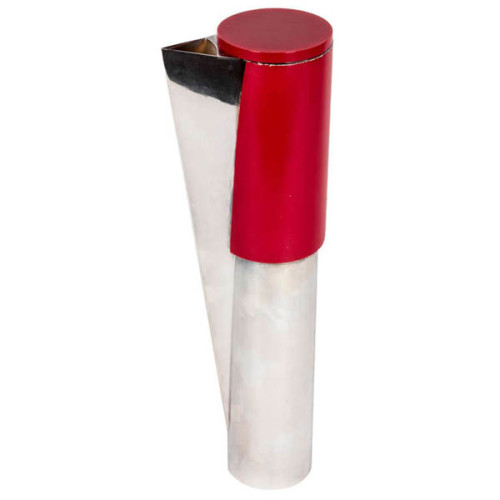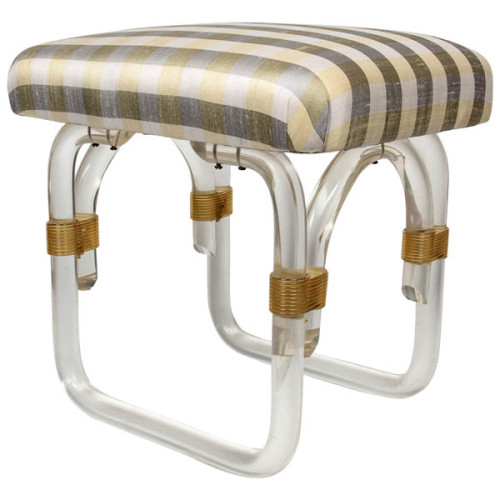Modern
-
Katherine S. Dreier, “International Exhibition of Modern Art 1926”, Arranged by The Societe Anonyme for the Brooklyn Museum 1926
KATHERINE S. DREIER (1877-1952)
“International Exhibition of Modern Art 1926” 1926
Arranged by The Societe Anonyme for the Brooklyn Museum
Published by Societe Anonyme, New YorkDimensions:
Book: H: 10 1/16” x W: 7 ½”
Custom leather box: H: 11 ¼” x W: 8 ¼” x D: 1 9/16”
Custom silk slipcase: H: 12” x W: 8 5/8” x D: 2 1/8”Katherine Sophie Dreier was born on 10 September 1877 in Brooklyn, New York to Dorothea Adelheid and John Caspar Theodor Dreier, both immigrants from Bremen, Germany; she was the youngest of five children. Early on, Dreier manifested her dual interests in social issues and art. She was treasurer of the German Home for Recreation of Women and Children and helped to found the Little Italy Neighborhood Association in Brooklyn, New York. She studied art privately, then at the Brooklyn Art School and at Pratt Institute, and then with Walter Shirlaw (with whom Dreier’s sister, Dorothea, also studied). There was a strong identification in the Dreier home with German culture, and the family often traveled to Europe to visit relatives. Between 1907 and 1914, Dreier spent much of her time abroad, traveling, studying art, and exhibiting her work in one-artist shows. In New York, in 1916, through her work with the Society of Independent Artists, Dreier met Marcel Duchamp. He was to become a close friend and colleague, and an important figure in the history of the Societe Anonyme. In January 1920, Dreier, Duchamp, and Man Ray met in Dreier’s apartment in New York City to found the Societe Anonyme, a society to promote modern art among the American public. Dreier had wanted to call the society “The Modern Ark,” but Man Ray later claimed that he was the one to suggest the French phrase for “incorporated” instead. Dreier added the subtitle “Museum of Modern Art: 1920.” The Societe Anonyme sponsored many lectures, concerts, publications, and exhibitions concerning modern art, including the International Exhibition of Modern Art at the Brooklyn Museum in 1926. In spite of a major membership campaign in 1925, the Societe’s headquarters in New York City closed in 1928, and from this point on, the Societe Anonyme existed only through Dreier’s efforts. She continued to organize events that were sponsored by the Societe, and she accumulated artwork to add to the Societe Anonyme’s collection. In 1939, Dreier began developing a plan to open the Country Museum at her house in West Redding, Connecticut (the Haven), which would house the Societe Anonyme’s collection of artwork, as well as her private collection. After little success with other potential investors, Dreier approached Yale University about funding and maintaining the museum. Yale was hesitant, because of the high costs of renovating the Haven and maintaining it as a fire-proof museum, and instead offered as a compromise to take over the Societe Anonyme’s collection if it were moved to the Yale Art Gallery. Dreier agreed, and she began sending the collection to Yale in October 1941. In 1942, Dreier was still adamant about her desire to open the Country Museum and to use her private collection as its basis. She continued her attempts to convince Yale to fund her project, but when Yale gave a final negative answer in April, Dreier decided to sell the Haven. In April 1946, she moved to a new home, Laurel Manor, in Milford, Connecticut. She continued to add artwork to the Societe Anonyme collection at Yale, through purchases and through gifts from artists and friends. In 1947, she attempted to reopen membership to the Societe Anonyme and printed a brochure, but Yale blocked distribution of the brochure because of the ambiguous connection between Yale and the membership campaign. In 1948, Dreier and Duchamp decided to limit the activities of the Societe to working on a catalog of the collection and to acquiring artwork. On the thirtieth anniversary of the Societe Anonyme’s first exhibition, 30 April 1950, Dreier and Duchamp hosted a dinner at the New Haven Lawn Club, where they formally dissolved the Societe Anonyme. In June, a catalog of the Societe’s collection at Yale, Collection of the Societe Anonyme: Museum of Modern Art 1920, was published. Dreier died on 29 March 1952.
-
Flavio Poli / Seguso Vetri d’Arte Murano Mid-Century Modern art glass vase c. 1950’s
FLAVIO POLI (1900-1984) Italy
SEGUSO VETRI D’ARTE ItalyVase c. 1950’s
Blue and clear Murano glass
H: 10″ x D: 3″ x W: 4 1/2″
Price: $1,850
Designer, businessman, ceramic artist. Born in Chioggia, he attended the Istituto d’Arte di Venezia and began work as a designer in ceramics. in 1929 he switched to glass and for Libero Vitali’s I.V.A.M. he designed animals, splendid Novecento-style nude figures in massiccio glass, as well as bowls and urns with figures resting on the inside, on lids or as handles. He subsequently collaborated with the Compagnia di Venezia e Murano, with the furnace of Mario and Lino Nason and with the engraver Gino Francesconi. in 1934 he accepted the artistic direction of Barovier, Seguso & Ferro, later to become Seguso Vetri d’Arte, and became partner three years later. Together with the master of the principal team Archimede Seguso, Poli was the author of grandiose lighting installations, of corroded vessels, of sculptures in bulicante glass, of animals in massiccio glass shaped while hot, productions which represented a milestone in the development of Murano glass. At the height of his artistic maturity, in the years between 1950 and 1960 he designed a series of sommerso glass pieces in a Nordic style, essential forms and sharp cold colors, which were awarded prestigious prizes (Compasso d’Oro). After leaving Seguso in 1963, between 1964 and 1966 he organized the artistic glass division at the Societˆ Veneziana di Conterie e Cristallerie.
-
PER SAX MOLLER / Scandinavian Modern Sterling sculptural centerpiece 2000
PER SAX MØLLER (b. 1950) Denmark
Round sculptural centerpiece with geometrical shapes 2000
Sterling silver
Marks: PER SAX MØLLER, Copenhagen, 925s, Sterling
Exhibited: Danske Sølsmede-nye arbejder (Danish silversmiths-new work), Museet på Koldingshus, 2002.
Diameter: 8 ¼”
Price: $12,500
The silversmith Per Sax Møller was trained in the Danish silver tradition with Jeweler to the Royal Danish Court, A. Michelsen, from 1968-1972. The workshop specialized in style copies and modern silver, which during the 1900’s was designed by architects such as Thorvald Bindesbøll, Kay Fisker, Erik Herløw, Tove and Edvard Kint-Larsen, among many others.
After completing his apprenticeship, he worked at Preben Salomonsen’s workshop in Copenhagen, mainly creating style copies for stores such as Tiffany, Bloomingdale’s and Aspery. Here, the ancient silversmith’s craft he had learned at A. Michelsen, was further honed. During the years 1973-1975, he attended classes at Guldsmedehøjskolen, but he was disappointed in the low standard of teaching and therefore did not graduate.
He found the opportunity for a far richer artistic education as a conscientious objector, stationed at the art museum Louisiana in Humlebæk, outside Copenhagen. He spent more than a year here, surrounded by the works of Henry Moore, Arp, Calder, Laurent and Danish artists such as Astrid Noack, Ejler Bille, Sonja Ferlov Mancoba, Villy Ørskov and many more, which left a deep and profound mark.In 1976, Per Sax Møller established himself in a workshop alongside goldsmith Jørgen Bindesbøll, in St. Kongensgade in Copenhagen. Over the next couple af years, he also joined the association “Danske Sølvsmede” in exhibitions throughout Scandivavia. He retired from the workshop with Jørgen Bindesbøll in 1980, but continued to create works in rented space. To help earn a living, he drove a city bus and worked for Folketeateret in Copenhagen, creating theatre sets.
Jørgen Bindesbøll moved to Møn in 1984, and Per Sax Møller took over his workshop in St. Kongensgade. Soon thereafter, he established himself in a workshop in Pilestræde, Copenhagen, and then in 1992, he took over silversmith Kay Bojesen’s workshop in Bredgade 47, where he resides today.
In the mid 1990’s Per Sax Møller rejoins “Danske Sølvsmede”, and in 1999 he succeeds silversmith Ib Andersen as president of the association. As president, he revitalizes Danish silver by initiating the exhibition Danish Silver 2000, which takes up most of the space in the museum Koldinghus and becomes one of the largest manifestations of Danish silver. During one summer month, the exhibition was visited by 30,000 guests.In 2002, Per Sax Møller resigns the presidency of “Danske Sølvsmede” to once again concentrate on his own works. Per Sax Møller has received Danish State Arts Foundation grant in 1979, 1997, 2000 and 2002. His works are represented at Oslo Museum of Art and Design, Danish Museum of Art and Design, at the museum Koldinghus and in private collections in Europe, USA and Canada.
-
Staffan Nilsson / Scandinavian Modern Sterling Pitcher 1992
STAFFAN NILSSON (b. 1949) Sweden
Pitcher 1992
Sterling silver, red acrylic
Marks: SNN P 925 S10
Staffan Nilsson’s work was included in the exhibition “Form and Function, Contemporary Swedish Silver,” the Swedish American Museum, Chicago, Oct. 12 – December 2, 2000.
H: 11 ½ “
Price: $8,000
*** A related teapot in sterling silver with a red acrylic handle can be found in the permanent collection of the Shanghai Museum and it is an innovative use red acrylic and sterling silver.
-
Grosfeld House New York (attr.) Modern / Art Deco Lucite Stool c. 1940
Grosfeld House New York
Lucite stool circa 1940.
Cylindrical lucite base stool with gold lucite wrap like connecting elements, silk upholstery.
H: 16 1/4″ x W: 13 1/2″ x D: 16 1/2″
Grosfeld House Furniture Company manufactured some iconic designs of the twentieth century. Some of the great designers that work for the company were Vladimir Kagan and Lorin Jackson. They produced some of the earliest chairs using Lucite starting in the 1930’s and through the Post War Era.
-
Wolfgang Gessl / Scandinavian Modern Sterling silver teapot with arching handle 1990
WOLFGANG GESSL (b. 1949) Austria / Sweden
Teapot 1990
Hand wrought and hand hammered spherical silver teapot with cylindrical handle and spout elements, maple and padouk wood layered arching handle
This is No. 2 out of the edition of 3 models.
Marks: Wolfgang Gessl (script impressed signature), 2/3, WO.GE (in a rectangle), Swedish assay mark for Stockholm, 925 (silver guarantee in a rectangle), E11 (in a rectangle), LF
Exhibited: Glänsande Geometri, Mettalum, Stockholm, Sweden
Illustrated: Gold and Silversmith Wolfgang Gessl: Exceeding Geometry, Kerstin Wickman, p. 16.
H: 10” x W: 16 ½” x D: 5 ½”
Price: $32,000
Wolfgang Gessl was born in 1949 in Vienna, Austria and trained as a goldsmith with Professor Hans Angerbauer. Upon moving to Sweden, Gessl studied under the eminent silversmith Sigurd Persson at Konstfack, the National University of Art, Craft and Design in Stockholm, Sweden.
Wolfgang Gessl has had fifteen solo exhibitions including shows at The National Museum, Stockholm and The Royal College of Art in London. His metalwork has been widely exhibited in Sweden, Europe and the U.S and his pieces can be found in many private collections throughout the world. He has taught at Konstfack for more than twenty-four years, and continues to live and work in Stockholm.






